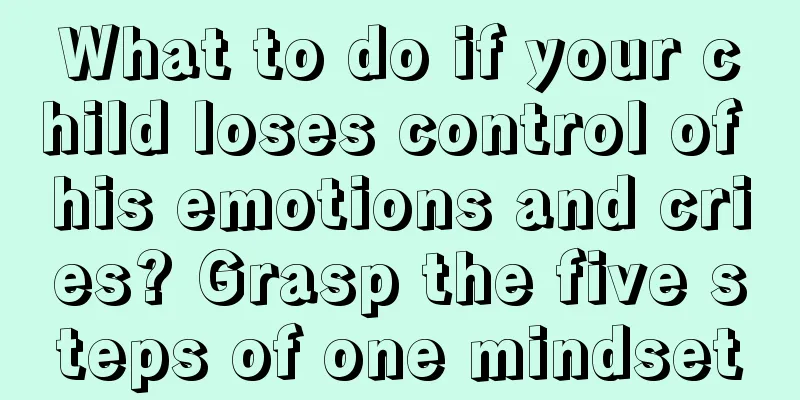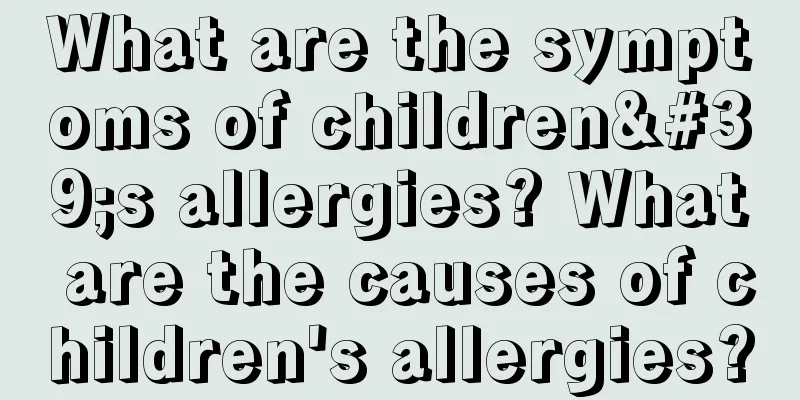What to do if your child loses control of his emotions and cries? Grasp the five steps of one mindset

|
It is inevitable that we will encounter children who lose control of their emotions. They scream, cry, and make a fuss. As parents, we don’t know how to help them. We feel helpless and distressed. Sometimes we can’t even control our temper and feel like a failure. Suppress them? Ignore them? Is this really a good thing to do? How should we deal with children who lose control of their emotions? Today, Mommy Love has compiled the practical experience provided by senior preschool teachers, "One Mindset, Five Steps". Let us embrace the anxiety and frustration in our children and deal with their emotions step by step! Children's tears, do you understand?On the one hand, it is because the child’s ability to express himself is not yet mature, and on the other hand, it may be because of his experience that only crying will get someone to respond, so when he needs attention, he chooses to express it by crying. But in fact, the unspoken frustration, anxiety, and frustration behind it are: "I have emotions, I have needs, and I hope you pay attention to me." When the child cries and we are powerless, it is easy to have two reactions: ignoring and suppressing. Maybe we can get a temporary effect (giving up crying because no one pays attention, or being beaten and scolded and being scared to be quiet), but in fact, these two reactions of parents are very harmful to the child... Ignoring will make children gradually lose their sense of security. Suppression will make children feel inferior and deny themselves. If a child's emotional needs are not met, it will have a great impact on their future development. Don't think that "hitting him will make him behave" or "ignoring him will make him fine", these will leave scars in the child's heart. So, what should we do? Today I will share with you a method and five steps. Let us learn together to take care of the helplessness and frustration of children! The principle of the mind method is to deal with your mood first, then deal with things.Don't preach to your child when he is out of control, it will only have the opposite effect! This principle actually runs through the entire processing steps, and will be explained step by step below Step 1: Hold back your denial and criticism——You think you are denying the behavior, and the child thinks you are denying him When we say, "Don't cry!", "Stop making a fuss!", "You're throwing things around again!", "Why are you so naughty!", we may want to correct the child's behavior at the moment, but the child will receive the message, "Mommy doesn't like me, Mommy is denying me..." In the long run, it is easy to cause the child to have a low sense of self-worth, or even feel unloved, which will cause irreparable damage. All we can do is to stop talking too fast! Step 2: Describe the situation and name the emotion——Help the child express himself, reduce the sense of helplessness, and describe his emotions with words, and empathize with his feelings. As we said before, part of the reason why the child cries is that he does not know how to express himself, so we can help him (also demonstrate) to describe the current situation and his emotions. On the one hand, it can reduce the child’s sense of helplessness (because he knows that you have received what he wants to express), and on the other hand, by empathizing with the child’s feelings, you can soothe his current mood. For example: "Mommy knows you're angry because you want cookies now." "You're sad now because you want to keep playing and don't want to go home, right?" Sometimes, such simple sentences can calm children down. After practicing a few times, you will find that it is not that difficult! Step 3: Accompany your child to find an emotional outlet——Suppressed emotions may develop into violence/inferiority complex, so it is better to give children more time to vent. The implicit Eastern culture rarely teaches us how to deal with negative emotions. It only stipulates "not to show them", not to cry, not to be angry, not to be weak... We have been educated in this way since we were young, and it is natural to use this set of rules to regulate our children. But in fact, emotions that are not expressed or released can easily cause "internal injuries" if they are suppressed in the heart, and even silently grow into violence or inferiority complex. Giving children more time, staying with them, and letting them know that they can vent their emotions at ease without hurting others is a great help and a precious educational opportunity. When you are sad, you can say, "If you are sad, cry first, mom will be with you." When you are angry, you can give your child a suggestion to vent safely: "If you are angry, you can hit this pillow and vent." Step 4: Teach your child how to express himself next time——Hug and deep breathing help calm the child, let the child know that talking is more effective than crying. When the child has almost vented, we can hug him and take deep breaths with him (these two methods have been proven to be quite effective~). As mentioned earlier, "never preach to the child when he is out of control." Only when the child calms down can he really listen to what you say. At this time, what you should do is not to blame or review his previous behavior, but to tell him gently and firmly: "Mommy didn't know what you wanted just now, because you kept crying and Mommy didn't understand. Next time you can say this..." By teaching children to express themselves correctly again and again, children will gradually know that clearly stating their needs can achieve their goals better than crying. Step 5: Provide your child with new options——Replace negative sentences with positive statements and give children “choices” instead of commands If we only say negative sentences (don't take the scissors! Don't draw on the wall!), the child will be at a loss and don't know what to do (so he may continue the original behavior). At this time, we can change to positive narration and add a "choice" to give the child some autonomy and space. Sometimes children like to sing the opposite tune, so compared to command sentences, giving children two choices, they will actually choose one of the two to do it! (Secretly, this trick is really useful~) for example: When your child doesn't want to go to bed, instead of directly ordering him to "go to bed!", you can try saying, "Do you want to sleep in this quilt or in your sleeping bag today?" When your child draws on the wall, instead of saying, "No! Draw on paper!", you can say, "Let's try drawing somewhere else. Do you want to draw on the sketchbook or on this blank paper?" Finally, I want to remind mothers that these changes will be difficult at first, and they are not panaceas. They will not be successful immediately after one use. We need time to change slowly, and children also need time to learn slowly. When we feel frustrated, we can remind ourselves: What we want is not for the child to not cry at the moment, but the future, when we can't be with him, whether he can wipe away his tears and start again. |
>>: How to choose children's boots and avoid falling into 4 misunderstandings
Recommend
Why is it that one eye is bigger than the other? Be alert to these four possibilities
Eyes are the most important organ in the human bo...
Can babies eat ginseng fruit? At what age can babies eat ginseng fruit?
Ginseng fruit is a fruit with a peculiar shape, w...
What should I do if my baby's fontanelle closes too early? What are the dangers of premature closure of my baby's fontanelle?
There are certain disadvantages if the baby's...
What is Panax notoginseng powder? What are the effects of Panax notoginseng powder?
Do you know what Panax notoginseng powder is? May...
Can I drink milk powder if I am infected with norovirus? Can I drink milk powder if I am infected with norovirus?
My baby used to drink milk powder, but recently h...
Can I eat winter dates during breastfeeding? Can I eat winter dates after I have given birth?
Jujubes are the most popular fruit for women, bec...
Which month of pregnancy is the most unsafe? It's not the first three months
After pregnancy, expectant mothers are often very...
Can you get pregnant if you have sex 40 days after giving birth? What should you pay attention to if you have sex 40 days after giving birth?
The mother's body is still in a recovery peri...
Is it a big deal if the baby's umbilical cord falls off? What should I do if the baby's umbilical cord falls off and bleeds?
The umbilical cord care of newborns is very impor...
Can babies eat a lot of amaranth? What can babies eat to enhance their immunity?
Babies' physical health is weaker than that o...
Can pregnant women eat tin foil clam powder? Can clam powder be cooked on a gas stove?
Clam vermicelli and clam rice noodles are both fa...
Why can't you eat sweets when you have little amniotic fluid? Pregnant women need to pay attention to two major factors
Eating some sweet food in moderation is good for ...
What is postpartum obsessive-compulsive disorder? Treatment of postpartum obsessive-compulsive disorder
Everyone is familiar with obsessive-compulsive di...
Can I eat green beans while breastfeeding? Is it good to eat green beans while breastfeeding?
In the hot summer, the green and attractive green...
When should I start drinking the tea for smooth delivery? Can the tea help with smooth delivery?
Natural childbirth is what almost all women hope ...









